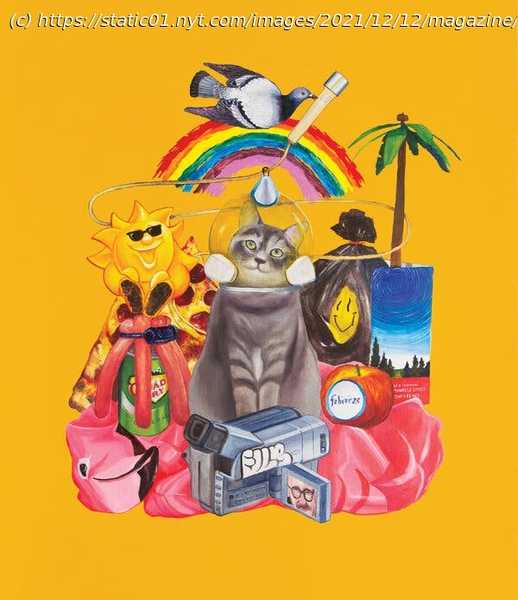In the second season of “How To With John Wilson,” the documentary filmmaker shows off his penchant for mutating the mundane into the vivid and extraordinary.
To hear more audio stories from publications like The New York Times, download Audm for iPhone or Android. You might think that there’d be something uncanny about walking around New York with the filmmaker John Wilson, insofar as that’s what much of his HBO series, “How To With John Wilson,” consists of: We see footage he’s magpie’d from around the city while he muses, in his thoughtful-Muppet voice, along baggy themes. A morning stroll near his building, in Ridgewood, Queens, did not offer up anything with the kind of Wilsonian surreality the show specializes in — but our destination, a dollar store Wilson described as one of his favorites, did. He told me that he spends a lot of time in dollar stores when he has writer’s block. Nearby he pointed out a display of tools from Trisonic, a budget brand he investigated in a 2016 short film, before collecting the things he’d come for: sink strainers, a miniature folding chair, a toilet seat with a fluffy white Pomeranian printed on its lid. On the way to the checkout, he marveled at a product he said he’d already purchased from a different dollar store: a clock radio with a built-in fish tank far too tiny for a fish, a “cool dollar-store-only object.” The entire place suddenly felt like a tidy analogue of Wilson’s show: filled with things too mundane, too accidentally strange, too tacky or sad or flawed or lacking in panache, to actively star in anyone else’s account of the world. “How To,” now in its second season, is (nominally) a tutorial, offering advice on subjects like wine appreciation and parking, and (formally) a documentary, following its themes to a bowling- ball factory or to interview a teenage real estate agent — and (ultimately) a form of memoir, a personal essay on video. But Wilson does magic with his staggering archive of street footage, all full of details that, if you encountered them yourself, you’d ponder for days: peculiar behaviors, dreamlike coincidences, strange omens and general “glitches in the Matrix,” as he puts it. Two workers mop a sidewalk in balletic unison; a man in a parked car idly sucks a woman’s toes; a woman places a live pigeon in a Duane Reade bag like a salad she’ll finish later. “Sharing your most intimate thoughts can be a disturbing and messy experience,” Wilson observes, as we watch a police officer pluck a sweater from a pool of blood on a subway floor. It would take a lot of footage to craft a timeline of romance from images of people publicly flirting, groping, proposing, marrying and bickering, and even more to end it with paramedics removing a corpse from an apartment building. Imagine the volume you’d need to be able to end it, as Wilson does, with paramedics dropping that body. There are highbrow precedents for Wilson’s close attention to the strange-and-ordinary, but what “How To” often resembles is the stuff you’d see posted to Twitter or TikTok in 20-second chunks, with glib captions about urban living or relatable moods. Wilson, who is 35, says that he loves seeing that kind of stuff online — “but I find it so tragic that it just kind of disappears.” He’d always felt compelled to build something larger from that material, lest it vanish into a “formless blob of content” or rot on an old hard drive. “The impulse to make the work like this to begin with,” he says, “was about giving a shape to all the stuff I was afraid of losing.” People talk about television’s capacity for novelistic depth, but surely the medium has more in common with pop music: We expect it to obey certain rhythms, resolve its motion in certain ways, pulse appealingly in the background even when our attention is divided. Part of what’s bewitching about “How To” is the extent to which it manages to replace those conventions with its own. “I get so bored watching something when I begin to realize the pattern,” Wilson tells me. Each of his episodes contains at least one moment in which you can scarcely believe the turn things have taken. The very first — “How To Make Small Talk,” which aired in October 2020 — leads Wilson from collecting a sweater from an ex to a vacation in Cancún, where he discovers MTV filming spring-break content; there he meets Chris, a weary-eyed party bro who eventually reveals that he came here in the wake of a friend’s suicide and is processing his grief in the least reflective environment imaginable. It’s one of a few remarkable turns in the episode. What’s more astonishing is that you might, watching it, have one of those rare TV experiences when you realize all the typical rhythms have fallen away, and what you’re watching has become unpredictable and alive — and somehow you’re not sure whether you’ve been watching it for 15 minutes or 45. Wilson presents as having lived the life of a middle-class tristate Everyman, only marbled with an obsessiveness that pulls him in deeply weird directions. He was born in Queens, to city natives who soon moved the family to Long Island. One of the first things he told me was that he was grateful for his parents’ support, in part because he’d been “a bit of a tyrant — I was just very focused on making my little movies, growing up.






